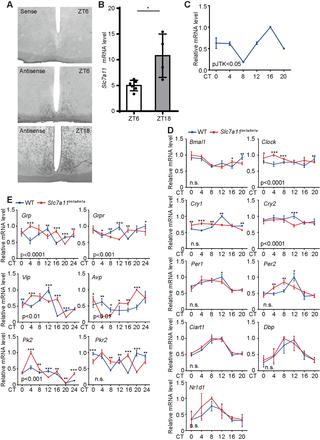当前位置:
X-MOL 学术
›
PLOS Genet.
›
论文详情
Our official English website, www.x-mol.net, welcomes your
feedback! (Note: you will need to create a separate account there.)
High-throughput discovery of genetic determinants of circadian misalignment.
PLOS Genetics ( IF 4.0 ) Pub Date : 2020-01-13 , DOI: 10.1371/journal.pgen.1008577 Tao Zhang , Pancheng Xie , Yingying Dong , Zhiwei Liu , Fei Zhou , Dejing Pan , Zhengyun Huang , Qiaocheng Zhai , Yue Gu , Qingyu Wu , Nobuhiko Tanaka , Yuichi Obata , Allan Bradley , Christopher J. Lelliott , Lauryl M. J. Nutter , Colin McKerlie , Ann M. Flenniken , Marie-France Champy , Tania Sorg , Yann Herault , Martin Hrabe De Angelis , Valerie Gailus Durner , Ann-Marie Mallon , Steve D. M. Brown , Terry Meehan , Helen E. Parkinson , Damian Smedley , K. C. Kent Lloyd , Jun Yan , Xiang Gao , Je Kyung Seong , Chi-Kuang Leo Wang , Radislav Sedlacek , Yi Liu , Jan Rozman , Ling Yang , Ying Xu ,
PLOS Genetics ( IF 4.0 ) Pub Date : 2020-01-13 , DOI: 10.1371/journal.pgen.1008577 Tao Zhang , Pancheng Xie , Yingying Dong , Zhiwei Liu , Fei Zhou , Dejing Pan , Zhengyun Huang , Qiaocheng Zhai , Yue Gu , Qingyu Wu , Nobuhiko Tanaka , Yuichi Obata , Allan Bradley , Christopher J. Lelliott , Lauryl M. J. Nutter , Colin McKerlie , Ann M. Flenniken , Marie-France Champy , Tania Sorg , Yann Herault , Martin Hrabe De Angelis , Valerie Gailus Durner , Ann-Marie Mallon , Steve D. M. Brown , Terry Meehan , Helen E. Parkinson , Damian Smedley , K. C. Kent Lloyd , Jun Yan , Xiang Gao , Je Kyung Seong , Chi-Kuang Leo Wang , Radislav Sedlacek , Yi Liu , Jan Rozman , Ling Yang , Ying Xu ,

|
Circadian systems provide a fitness advantage to organisms by allowing them to adapt to daily changes of environmental cues, such as light/dark cycles. The molecular mechanism underlying the circadian clock has been well characterized. However, how internal circadian clocks are entrained with regular daily light/dark cycles remains unclear. By collecting and analyzing indirect calorimetry (IC) data from more than 2000 wild-type mice available from the International Mouse Phenotyping Consortium (IMPC), we show that the onset time and peak phase of activity and food intake rhythms are reliable parameters for screening defects of circadian misalignment. We developed a machine learning algorithm to quantify these two parameters in our misalignment screen (SyncScreener) with existing datasets and used it to screen 750 mutant mouse lines from five IMPC phenotyping centres. Mutants of five genes (Slc7a11, Rhbdl1, Spop, Ctc1 and Oxtr) were found to be associated with altered patterns of activity or food intake. By further studying the Slc7a11tm1a/tm1a mice, we confirmed its advanced activity phase phenotype in response to a simulated jetlag and skeleton photoperiod stimuli. Disruption of Slc7a11 affected the intercellular communication in the suprachiasmatic nucleus, suggesting a defect in synchronization of clock neurons. Our study has established a systematic phenotype analysis approach that can be used to uncover the mechanism of circadian entrainment in mice.
中文翻译:

高通量发现昼夜节律失调的遗传决定因素。
昼夜节律系统通过使生物适应环境线索的日常变化(例如明/暗循环)来为生物提供适应性优势。昼夜节律时钟的分子机制已被很好地表征。然而,尚不清楚如何将内部昼夜节律时钟带入规律的每日明/暗周期。通过收集和分析可从国际小鼠表型研究协会(IMPC)获得的2000多只野生型小鼠的间接量热(IC)数据,我们表明,活动的开始时间和高峰期以及进食节律是筛选缺陷的可靠参数昼夜节律失调。我们开发了一种机器学习算法,以利用现有数据集对未对准屏幕(SyncScreener)中的这两个参数进行量化,并用它来筛选来自五个IMPC表型中心的750个突变小鼠系。发现五个基因(Slc7a11,Rhbdl1,Spop,Ctc1和Oxtr)的突变体与活动或食物摄入模式的改变有关。通过进一步研究Slc7a11tm1a / tm1a小鼠,我们证实了其对模拟的时差反应和骨架光周期刺激的高级活动期表型。Slc7a11的中断影响了视交叉上核中的细胞间通讯,表明时钟神经元的同步性存在缺陷。我们的研究建立了系统的表型分析方法,可用于揭示小鼠昼夜节律夹带的机制。发现五个基因(Slc7a11,Rhbdl1,Spop,Ctc1和Oxtr)的突变体与活动或食物摄入模式的改变有关。通过进一步研究Slc7a11tm1a / tm1a小鼠,我们证实了其对模拟的时差反应和骨架光周期刺激的高级活动期表型。Slc7a11的中断影响了视交叉上核中的细胞间通讯,表明时钟神经元的同步性存在缺陷。我们的研究建立了系统的表型分析方法,可用于揭示小鼠昼夜节律夹带的机制。发现五个基因(Slc7a11,Rhbdl1,Spop,Ctc1和Oxtr)的突变体与活动或食物摄入模式的改变有关。通过进一步研究Slc7a11tm1a / tm1a小鼠,我们证实了其对模拟的时差反应和骨架光周期刺激的高级活动期表型。Slc7a11的中断影响了视交叉上核中的细胞间通讯,表明时钟神经元的同步性存在缺陷。我们的研究建立了系统的表型分析方法,可用于揭示小鼠昼夜节律夹带的机制。我们证实了其对模拟的时差反应和骨骼光周期刺激的高级活动期表型。Slc7a11的中断影响了视交叉上核中的细胞间通讯,表明时钟神经元的同步性存在缺陷。我们的研究建立了系统的表型分析方法,可用于揭示小鼠昼夜节律夹带的机制。我们证实了其对模拟的时差反应和骨骼光周期刺激的高级活动期表型。Slc7a11的中断影响了视交叉上核中的细胞间通讯,表明时钟神经元的同步性存在缺陷。我们的研究建立了系统的表型分析方法,可用于揭示小鼠昼夜节律夹带的机制。
更新日期:2020-02-18
中文翻译:

高通量发现昼夜节律失调的遗传决定因素。
昼夜节律系统通过使生物适应环境线索的日常变化(例如明/暗循环)来为生物提供适应性优势。昼夜节律时钟的分子机制已被很好地表征。然而,尚不清楚如何将内部昼夜节律时钟带入规律的每日明/暗周期。通过收集和分析可从国际小鼠表型研究协会(IMPC)获得的2000多只野生型小鼠的间接量热(IC)数据,我们表明,活动的开始时间和高峰期以及进食节律是筛选缺陷的可靠参数昼夜节律失调。我们开发了一种机器学习算法,以利用现有数据集对未对准屏幕(SyncScreener)中的这两个参数进行量化,并用它来筛选来自五个IMPC表型中心的750个突变小鼠系。发现五个基因(Slc7a11,Rhbdl1,Spop,Ctc1和Oxtr)的突变体与活动或食物摄入模式的改变有关。通过进一步研究Slc7a11tm1a / tm1a小鼠,我们证实了其对模拟的时差反应和骨架光周期刺激的高级活动期表型。Slc7a11的中断影响了视交叉上核中的细胞间通讯,表明时钟神经元的同步性存在缺陷。我们的研究建立了系统的表型分析方法,可用于揭示小鼠昼夜节律夹带的机制。发现五个基因(Slc7a11,Rhbdl1,Spop,Ctc1和Oxtr)的突变体与活动或食物摄入模式的改变有关。通过进一步研究Slc7a11tm1a / tm1a小鼠,我们证实了其对模拟的时差反应和骨架光周期刺激的高级活动期表型。Slc7a11的中断影响了视交叉上核中的细胞间通讯,表明时钟神经元的同步性存在缺陷。我们的研究建立了系统的表型分析方法,可用于揭示小鼠昼夜节律夹带的机制。发现五个基因(Slc7a11,Rhbdl1,Spop,Ctc1和Oxtr)的突变体与活动或食物摄入模式的改变有关。通过进一步研究Slc7a11tm1a / tm1a小鼠,我们证实了其对模拟的时差反应和骨架光周期刺激的高级活动期表型。Slc7a11的中断影响了视交叉上核中的细胞间通讯,表明时钟神经元的同步性存在缺陷。我们的研究建立了系统的表型分析方法,可用于揭示小鼠昼夜节律夹带的机制。我们证实了其对模拟的时差反应和骨骼光周期刺激的高级活动期表型。Slc7a11的中断影响了视交叉上核中的细胞间通讯,表明时钟神经元的同步性存在缺陷。我们的研究建立了系统的表型分析方法,可用于揭示小鼠昼夜节律夹带的机制。我们证实了其对模拟的时差反应和骨骼光周期刺激的高级活动期表型。Slc7a11的中断影响了视交叉上核中的细胞间通讯,表明时钟神经元的同步性存在缺陷。我们的研究建立了系统的表型分析方法,可用于揭示小鼠昼夜节律夹带的机制。











































 京公网安备 11010802027423号
京公网安备 11010802027423号